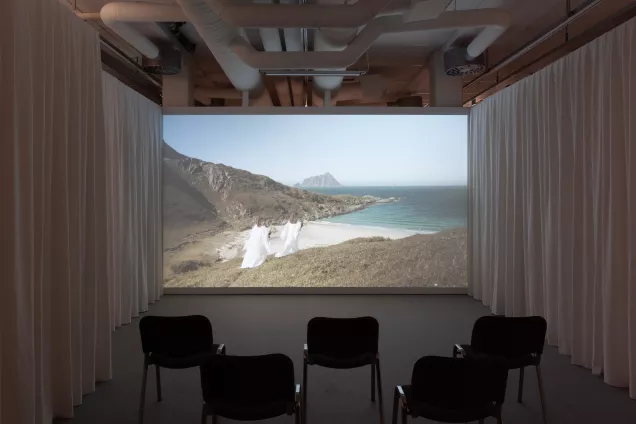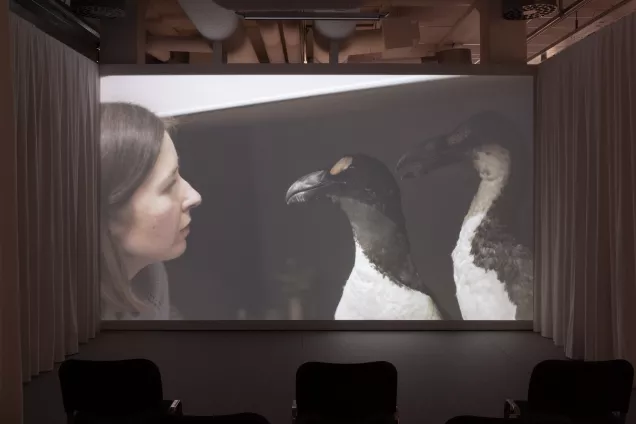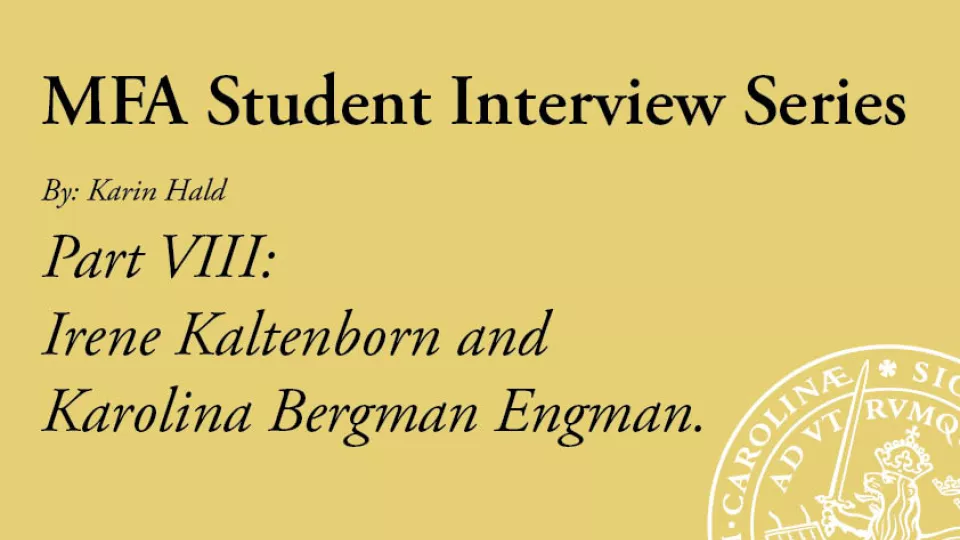Irene Kaltenborn
In KHM1 gallery Irene Kaltenborn´s MFA exhibition Choreographies towards loss set the stage for the audience to enter artworks which echoed loss and a void, full of wonderment and poetics. The gallery was dimly lit and kept minimal, leaving room for the viewer to enter the web of interconnectedness between animals, humans and nature.
What has the process been like creating your MFA exhibition?
I always begin my process with months of research, and for this exhibition it began in the beginning of 2023. It has been amazing to get so much time to do in-depth research before starting the production, and it was also very necessary to use time as a tool in relation to the topic I chose to work with. I needed to reach out to various people in order to make the film, that is the centerpiece of the exhibition, and I also traveled to Iceland, England, Norway and Belgium to film.
I think the best part of this is that I had many limitations that forced me to really think and reflect on all the stages of the process. I was very lucky to get several scholarships that made all the traveling possible, but I had no cinematographer and needed to be in front of the camera throughout the film. So, I taught my partner to use a cinema camera and got help from two other colleges that did not have much experience with the moving image either. This was very challenging, and we faced so many obstacles, but we also had this enormous freedom that I think has given the work an interesting framework.
What has been your inspiration?
It all started when I was told a story from the island I grew up on. In 1936 Norway wanted a penguin colony of their own and imported nine king penguins from Antarctica. Five of them were released outside Magerøya but disappeared after a week. When looking into the archives, I read about people seeing the penguin at different places around the coast but thinking it was another bird. The bird they thought they had seen was called the Great Auk and got extinct in 1844.
Someone told me that the entrails of the last two Great Auks are now kept at the old Zoological Museum in Copenhagen, and I had for some time been interested in making a work dealing with extinction. With the aim of breaking the immunity we seem to have towards species disappearing and translate numbers into a physical feeling of loss.
The exhibition is made up of (only) two works. For me it gave the works more space and allowed me to move into the depth of them quite easily, yet it also seemed like a bold choice. How have your worked with imaging the space and works within it?
It was very clear from the beginning that I wanted to make a film, and I could not visualize it in the space with anything else. As I started to film and speak to people from different disciplines that could bring me closer to Great Auk, I realized that the empty space could be my most important tool. I wanted the film to be a sensorial depiction of loss and started to imagine the visitor watching the film and coming out to a room deprived of content. The gallery space allowed me to control the first impressions the viewer got after seeing the work, and I think it has been very important to create this context for the work.
When I saw the video work, Choreographies towards loss, one of the things which struck me the most was the look in your eyes when talking to Errol Fuller, who has a home filled with extinct birds and other artifacts linked to animals. Your look seemed to be filled with wonderment and joy in an almost childish manner that moved me. When dealing with such a political topic as extinction, this gave me the feeling that you try to hold on to softness and openness rather than more dark emotions?
Meeting Errol was amazing, and seeing his home was breathtaking in many ways. So, I can really relate to the feeling you describe. It is difficult to make a work about extinction, and the story about the Great Auk is extremely sad. My visual language is very poetic, and I am occupied with using the moving image to create meditative experiences that hypnotize. So, I thought that my way of working could deal with the topic in a different way than what I have seen, and hopefully move something in the viewer. I also appear as the Great Auk myself together with two other performers that represent the two closest relatives of the extinct bird. And in the end, the Great Auk is allowed to disappear into ocean. I have tried to create a work that goes beyond and cross different genres, and by not following a convention the film opens up for new ways of understanding loss.
Irene Kaltenborns's exhibition was displayed at Malmö Art Gallery (KHM1) August 9th - August 24th 2024.
Interview by Karin Hald.
Karolina Bergman Engman
In the KHM2 Gallery Karolina Bergman Engman had made an exhibition entitled Ekon frän den andra stranden (Echoes from the other shore). The exhibition space was darkly lit and small lightboxes with images seeming like faint memories led me around the space, finally leading me to a video work, where the ferry voyage between Estonia and Sweden was shown in black and white images, filled with political implication and history which reaches into the artist own life as well as Western society.
What has the process been like creating this MFA exhibition?
It has been an intuitive process of research and collecting material. A process that started on the first ferry trip I took between Sweden and Estonia for the project. After spending time on the ferry I got used to taking notes of my surroundings when traveling, for example how the light traveled across the walls inside the ferry. I made sound recordings with contact microphones and used a zoom recorder to record pipes and other mechanics. I wanted somehow to engage with the place fully and understand the ferry as an intermediary space.
I found that the decision to film with analogue film changed how I treated my filming process. Usually I would have hours of filmed material to choose from - here I realized there was a restriction of the amount of material and I needed to be more selective of what I was filming. I decided to sit and wait for the moments I was looking for with the camera, I needed to be fully present for the shards of moments I was trying to capture. I started to develop a new method of thinking while filming.
Working with the camera is to me a way to understand myself and my perception, it is a tool to understand how I perceive the world and the environments I place myself in.
In this case it became very concentrated since I needed to be more precise. In the end I found myself creating my own schedule of moving around the ferry, where my routines were formed by the clips I was looking for. In the editing process I continued being driven by intuition, this is to me the part of the process where all the pieces come together- sound and image create a symphony in relation to each other.
What has been your inspiration?
A mix of impressions - moments that spontaneously appear in my everyday life that I feel an urge to document. I am attracted to ambience, which to me usually translates into sound or image. I usually carry a zoom recorder with me, I treat the device like a sketchbook. You never know when you hear a noise that sounds like what you want to say. In the search of ambience I look for something familiar that directs immersion. I want to capture the transience of the moment.
The aesthetic of the works, both the light boxes but especially the video work Ekon från den andra stranden seems to be placed somewhere in between nostalgia and the present. There is this time span which I felt you created by what was filmed (the cafeteria on the ferry, the furniture etc) and how it was filmed (digitized 16mm film). Has this been crucial to your work - the play between connecting the past and the present?
I think the nostalgic aesthetic of the ferry’s interior suggests that we are placed somewhere else in time. To me it is a time capsule where I am automatically transported to my childhood, but also to a different decade. Then there is this additional layer of uncanniness, the short sequences that take place outside the ferry acting as disruptions. They look like archive images, but are filmed in the present reflecting a past - in that sense they also play with layers of time. The materiality of the analogue film echoes something distant with its grain and the motifs I’ve chosen to film. There is also this contradiction of time layers between the black and white film together with the digital sound. I am not sure if I am looking at a film or a sound installation. To me these contradictions have been important for the work, to get the sense of an intermediary space. It is this constant feeling of displacement that I think has been interesting to work with.
I had the sensation of walking into a photo album when entering the show - the whole presentation of the works was very tangible yet played on memories that were not at all mine. How did you work with engaging the works with the gallery space, where the light and the works become intertwined?
The installment was very playful and intuitive. I wanted to create a spatial narrative with the images where past and present were mixed, with a similar language as in the film. The filmstrips are placed as interruptions, being transported to someplace else and then landing in the location we started with the larger boxes depicting still-lifes of the ferry. I wanted the viewer to have a curious approach when taking in the works, where you would search for images in different corners of the room. In a similar way as I have found the placement for them. After watching the film you would interpret them and the space differently. The light is a symbol in the film that I also wanted to intertwine with the space and the images. In the dark ambient space, you search for a light.
Karoline Bergman Engman's exhibition was displayed at Malmö Art Gallery (KHM2) August 9th - August 24th 2024.
Interview by Karin Hald.
Exhibition photos
Choreographies towards loss, by Irene Margrethe Kaltenborn
Ekon från den andra stranden (Echoes from the other shore), by Karolina Bergman Engman

Choreographies towards loss, by Irene Margrethe Kaltenborn. Photo: Youngjae Lih.

Ekon från den andra stranden (Echoes from the other shore), by Karolina Bergman Engman. Photo: Youngjae Lih.

Choreographies towards loss, by Irene Margrethe Kaltenborn. Photo: Youngjae Lih.

Ekon från den andra stranden (Echoes from the other shore), by Karolina Bergman Engman. Photo: Youngjae Lih.

Choreographies towards loss, by Irene Margrethe Kaltenborn. Photo: Youngjae Lih.

Ekon från den andra stranden (Echoes from the other shore), by Karolina Bergman Engman. Photo: Youngjae Lih.

Choreographies towards loss, by Irene Margrethe Kaltenborn. Photo: Youngjae Lih.

Ekon från den andra stranden (Echoes from the other shore), by Karolina Bergman Engman. Photo: Youngjae Lih.

Choreographies towards loss, by Irene Margrethe Kaltenborn. Photo: Youngjae Lih.

Ekon från den andra stranden (Echoes from the other shore), by Karolina Bergman Engman. Photo: Youngjae Lih.

Choreographies towards loss, by Irene Margrethe Kaltenborn. Photo: Youngjae Lih.

Ekon från den andra stranden (Echoes from the other shore), by Karolina Bergman Engman. Photo: Youngjae Lih.

Choreographies towards loss, by Irene Margrethe Kaltenborn. Photo: Youngjae Lih.

Ekon från den andra stranden (Echoes from the other shore), by Karolina Bergman Engman. Photo: Youngjae Lih.
